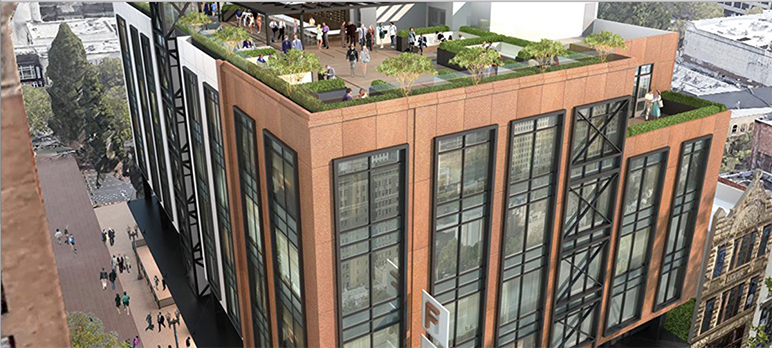Urban Catalyst—a firm redeveloping San Jose’s federally designated Opportunity Zones to qualify for long-term tax breaks—plans to build a rooftop bar on the Fountain Alley Building, which is slated to replace the Lido nightclub. The developers boast that the 5,000-square-foot top-level watering hole will be the largest rooftop bar in Silicon Valley.
Details about the project surfaced earlier this week when Urban Catalyst submitted a permit application to the San Jose Planning Department, proposing to transform Lido’s old digs at 34 S. First St. into a six-story building with 73,000 square feet of office space, 14,000 square feet of retail and a restaurant on the ground floor.
And with a flourish so that Fountain Alley can live up to its name: the plans call for a nearby decorative fountain.
“Our goal is to revitalize San Jose,” Urban Catalyst founder Erik Hayden says. “In New York and Chicago, they have these amazing rooftop bars and they might only have three to four months a year to use them. Here in San Jose Silicon Valley, we have 300 days of sunshine. We want to take advantage of that and provide a rooftop bar where people can gather and have beautiful views of the city, the urban area and the surrounding hills.”
Urban Catalyst in May paid developer Gary Dillabough $6.9 million for the site of the future Fountain Alley Building, which is set to break ground in 2021. Dillabough, who co-owns land investment company Urban Community with real estate broker Jeff Arrillaga, maintained a stake in the deal by becoming partners in the Fountain Alley project.
Dillabough, who scooped up the nearby Bank of Italy building in 2017 for $30 million, has a keen interest in revitalizing that part of downtown.
It all lines up perfectly for Hayden.
“Our retail goes all along First Street and wraps down Fountain Alley,” he says. “That’ll be great for the neighborhood because Dillabough and Arrillaga own the Bank of Italy building and they will have retail that wraps all the way around Fountain Alley as well.”
Urban Catalyst was formed to take advantage of Opportunity Zones, a program created as part of the Republican-led tax cuts as a way to spur investment in poor neighborhoods. The area around Fountain Alley is one such zone, which allows investors to claim capital gains relief if they stick with a project for the long term.
Once the federal government handed down more specific guidelines about how to qualify for the tax incentives, funds like Urban Catalyst began cropping up throughout the country. “We started raising funds in February,” Hayden says. But once the IRS clarified the rules of the game, the money started pouring in more freely, he adds.
Opportunity Zone investors enjoy extra tax breaks if they finalize their buy-in before the end of 2019. That’s made for a busy year for Urban Catalyst. In July, it acquired Hub Cap City and Custom Apparel in Midtown. In August, it bought the Chevron gas station at 147 E. Santa Clara St. And in September, it acquired another two choice properties at the corner of West San Carlos Street and Gifford Avenue.
Meanwhile, the firm is closing in on two additional acquisitions, Hayden says. And Urban Catalyst will announce three more projects in 2020. That’s 10 in all, which represents more than $1 billion in local investment.


> The developers boast that the 5,000-square-foot top-level watering hole will be the largest rooftop bar in Silicon Valley.
Seems like a dying business model.
My guess is there would be fewer and fewer customers for “watering holes” and a growing number of customers for “vaping holes” or “toking holes” or “snorting holes” or “injecting holes”.
I don’t know much about these things, but wouldn’t old fashion booze interfere with a person’s enjoyment of his or her meth or opioid addiction?